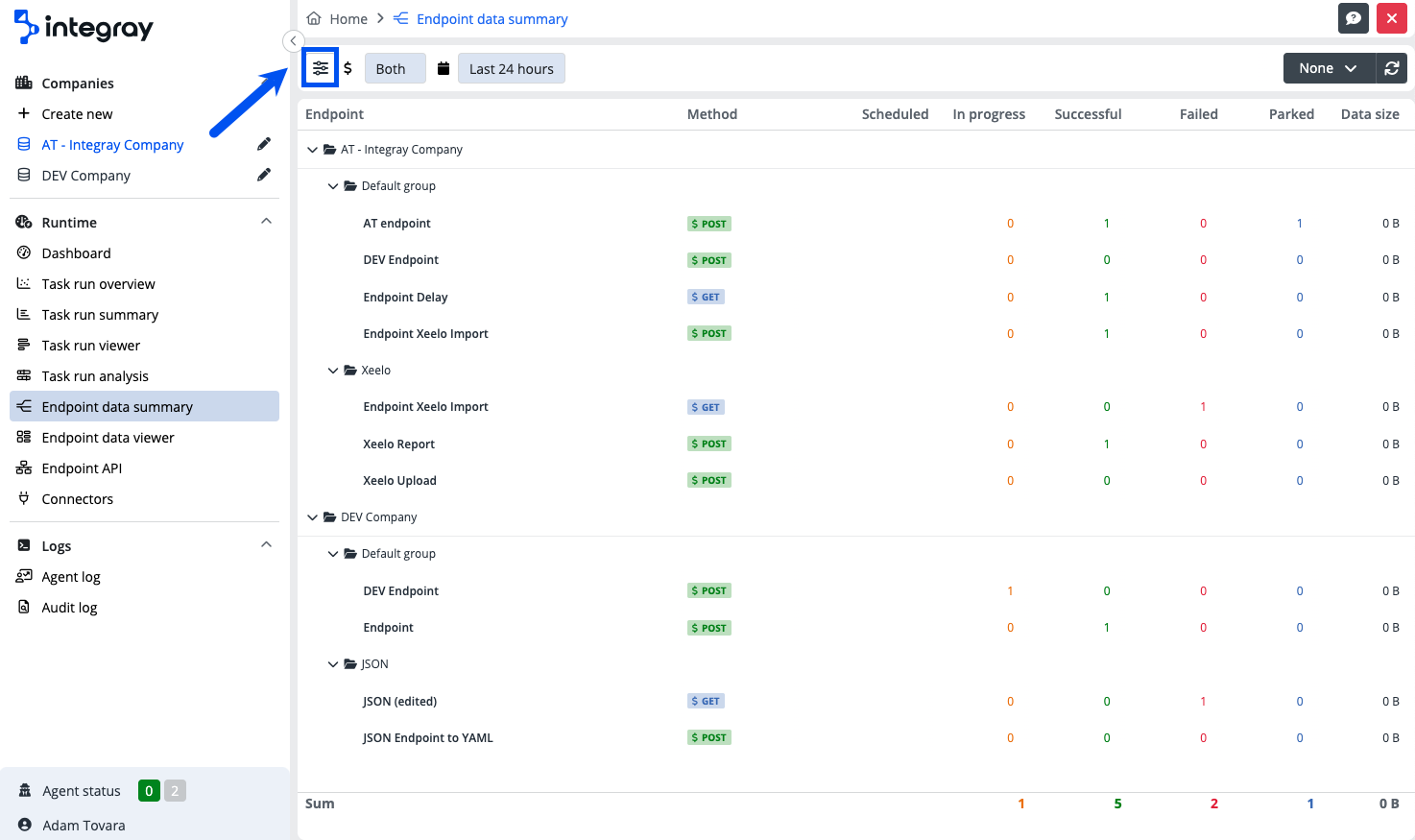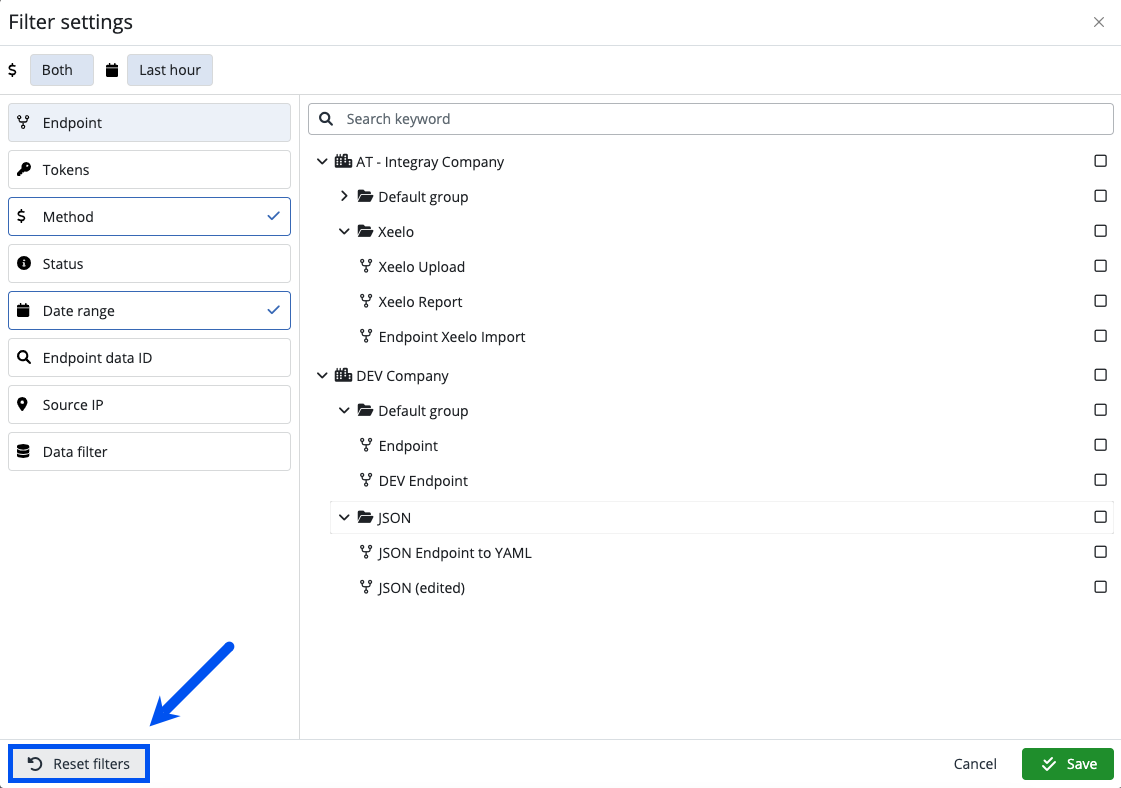Endpoint data summary
Building a comprehensive content for you: A Work in Progress...
The Endpoint data summary is a view providing the user with an overview of the aggregated data counts for the configured active endpoints.
flowchart TD
A[<b>Endpoint data summary</b>]:::someclass --> B[Endpoint data viewer]
B --> C[Task runs]
B --> D[Data viewer]
C --> E[Task history view + Log]
G[Dashboard] --> E
E --> F[Task step data snapshot]
H[Task run summary] --> I[Task run viewer]
I --> E
J[Task run analysis] -- Filter: Outliners only --> I
K[Home screen Task run search] --> E
classDef someclass fill:#ebf5ebResult view
The result view is structured into a tabular format including columns: Endpoint, Method, Scheduled and the counts of task runs in individual statuses: In progress, Successful, Failed, Parked and Data size.
-
Endpoint - The column endpoint is organized in a structured way displaying Company -> Endpoint group -> Endpoint.
-
Method - Displays the method configured and used for the respective endpoint: GET, POST, PUT, DELETE, PATCH.
Counts of task runs in individual statuses:
-
Scheduled - Count of the task runs scheduled for future runs.
-
In progress - Count of the task runs currently in progress. All task runs with the execution status 1xx are counted here.
-
Successful - Count of the finished task runs. All task runs with the execution status 2xx are counted here.
-
Failed - Count of the failed task runs. All task runs with the execution status 3xx are counted here.
-
Parked - Count of the parked task runs
-
Data size - If any data is produced, the size of the data is displayed. This feature is by default switched off. Use the built-in filters to show the Data size.
All displayed count results in the summary are active and clickable. Clicking on the numbers navigates you to the Endpoint data viewer with the applied filter on respective company, endpoint, method and date range. Data records in the endpoint data viewer are displayed per task run.
Filters
The endpoint data summary view includes built-in filters to narrow down the result data set.
Every filter has a multiple value selection feature available. If more values are selected within one filter, a logical operator OR applies among the selected values.
The visibility of the values to select in the filters are driven by the user access rights. The administrators can see any company, enpdoint group, and endpoint in the filters. The standard users can only see the values related to the companies they own or have access to. E.g. the company owner, can filter on the endpoints realted to the owned company.
You can enter the built-in filters by clicking the button on the left side and opening the modal dialog window.
Built-in filters
You can narrow down the resulting data set by filtering within the following items: Endpoint, Method, Status, Date range.
- Endpoint - Select the required endpoint.
- Method - Select the required Method (All or just the GET, POST, PUT, DELETE, PATCH)
-
Status - Select the required status. See below the status table.
ID Status description ID Status description 0 Unknown 301 Failed agent killed 1 Scheduled 302 Failed timeout 100 In progress 303 Failed cancelled by user 101 Waiting for agent 304 Failed run time 200 Finished success 305 Failed agent 201 Finished no data 306 Failed output 202 Finished with errors 307 Failed input 203 Nothing to process 999 Parked 300 Failed connector Generally, statuses 1xx - represent "in progress", 2xx - represent "finished", 3xx - represent "failed".
-
Date range - Select the required date range from the Predefined ranges
Last minute,Last 5 minutes,Last 10 minutes,Last hour,Last 3 hours,Last 12 hours,Last 24 hours,Last week. Additionally, a custom date range can be set - From:Date&Time, To:Date&Time.
Usage of the filters:
Choose the required type of filter on the left side and configure it on the right side. Used filters are marked with an active marker icon on the left side, as well as those are visible as buttons on the filter menu and preview. To cancel the active filter, click the cross icon on the right side of the button. If the button does not contain a cross to remove the filter, it means the filter is default and can't be removed.
You can reset all the filters by clicking the Reset filters button in the left bottom corner of the Filter settings. The filter will be set to the default values.
Number of displayed endpoints
The endpoint data summary can display up to 100 endpoints. If the number of endpoints to be displayed is greater than 100, you will be prompted by the system and asked to use the built-in filters to limit the set of displayed endpoints.




